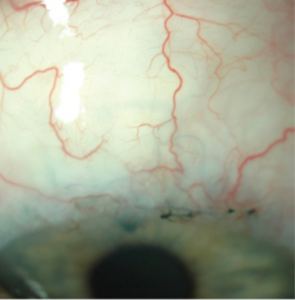What is a Trabeculectomy?
When treatment with eye drops, tablets or laser surgery does not lower the pressure inside the eye (intraocular pressure) to a safe level, the Glaucoma Consultant may recommend glaucoma surgery. The commonest glaucoma operation is called a trabeculectomy, located beneath the upper eyelid (Figure 1).
During this operation, a new channel in formed within the eye by removing a tiny piece of the wall of the eye, which allows the liquid causing the excess pressure to escape through a new opening into a reservoir (called a bleb) underneath the surface covering of the eye.
An anti-scarring medication (called Mitomycin C) is used at the time of the operation to help reduce postoperative scarring and plugging up of the newly formed channel. This medication is licensed to treat bladder cancers because it reduces cell multiplication. It has been safely used in glaucoma surgery since the 1990s to improve the success rates of this operation, although it is not licensed for use in the eye. The medication is applied to the area in Figure 1 and then thoroughly washed out. No other part of your body or eye is treated with this medication.
The aim of the operation is to lower the pressure inside the eye, to try to prevent further glaucoma damage and to try and protect your eyesight from future, further deterioration.
In most cases, your vision will remain unchanged although often, there is some blurring of vision for several days afterwards and sometimes mild discomfort. Rarely there can be loss of sight.

The eye pressure is lessened as the extra liquid fluid drains through the new opening into a little pool underneath the surface coating of the eye (conjunctiva).
What to do before Trabeculectomy?
Eye drops and tablets for glaucoma are continued until the time of surgery. Sometimes, the doctor, for up to two weeks before the surgery, may stop an eye drop or tablet. If you take aspirin or warfarin, you may be asked to reduce or stop this medication to prevent bleeding if your GP agrees.
What type of anaesthesia is used?
Trabeculectomy may be performed using a general anaesthetic (when you are asleep) or a local anaesthetic (you are awake but feel nothing). An injection of local anaesthetic involves introducing anaesthetic liquid medication around the eye, which numbs the eye completely and prevents eye movements.
The surgery itself takes about one hour in most cases.
What happens after Trabeculectomy?
After Trabeculectomy, the eye is usually covered by a plastic shield overnight. Your postoperative eye drops are used to relax the muscles in the eye, to prevent infection, and reduce soreness and swelling. Occasionally, a tablet may be given to further reduce inflammation. It is important to take this medicine as directed to make sure the operation is successful.
For the first few weeks certain anti-inflammatory eye drops may be prescribed every one to two hours. These should be instilled during waking hours only i.e. you do not need to get up in the middle of the night to put these eye drops in.
The Surgeon will examine your eye either the same day before you are discharged or the following day. Your other postoperative appointments will usually be scheduled as follows:
- Weeks 1, 2, 3, 4 and then
- Sometimes months 2 and 3 before you see your optician
The surgeon will check how the operation is working and make adjustments to the trabeculectomy to get the best surgical result. Sometimes an anti-scarring medication is given to the eye postoperatively. During this time, the eye may have a very low pressure and it is important to protect the eye and avoid lifting heavy things, straining, or rubbing the eye. It is also important to keep the eye clean and dry since there is always an infection risk soon after an operation. You should avoid booking a holiday for approximately 6-8 weeks after the operation.
Possible Complications
Possible complications include too low a pressure, cataract, or excessive scarring. The scar tissue can overgrow the site of the operation and seal the drainage channel. If this occurs, the eye pressure will rise again and require a return to eye drops, tablets or possibly another operation. Rare complications include bleeding and infection.
Your vision may be slightly blurred for a few days to several weeks after the operation. You may be advised to change your glasses after the operation and usually this will be about 3 months after the operation once your eye has settled down. Very rarely your vision may become blurred due to an inflammatory reaction to this operation and may require prolonged anti-inflammatory eye drops to settle this. Very rarely your vision may permanently deteriorate after the operation and this can be a risk if you have very advanced glaucoma damage.
Success with Trabeculectomy
As a general rule approximately 80% of operated eyes will have satisfactory eye pressure and no need for medicine after the operation. If eye drops are added, over 90% of eyes will have a satisfactory lowering of eye pressure.
Further information about glaucoma may be found on the Glaucoma UK website via
www.glaucoma.uk/about/treatments-surgery/trabeculectomy-surgery/
